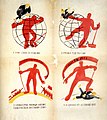ROSTA windows
This article includes a list of general references, but it lacks sufficient corresponding inline citations. (January 2018) |

ROSTA windows (also known as ROSTA windows of satire or ROSTA posters, Russian: Окна сатиры РОСТА, Окна РОСТА, ROSTA being an acronym for the Russian Telegraph Agency, the state news agency from 1918 to 1935) were a propagandistic medium of communication used in the Soviet Union to deliver important messages and instill specific beliefs and ideology within the minds of the masses.
Rosta posters were a highly popularized form of communication used by the Russian government during a short time period between 1919 - 1921. The posters were used to communicate mass messages and propaganda during the Russian Civil War. Once the war came to an end, the Russian government turned to new forms of communication.[1]
Rosta posters were easily identifiable by their context and distinct style.
Examples
[edit]-
Vladimir Mayakovsky, "Want it? Join"
-
Vladimir Mayakovsky, "Poster #742"
-
Mayakovsky, "Мир стоит на вулкане"
See also
[edit]- TASS windows, the Soviet News Agency's series of hand-printed propaganda posters during World War II 1941 – 1945
- Agitprop
References
[edit]- "Views and Re-Views: Soviet Political Posters and Cartoons | Artists: P-Z". library.brown.edu. Retrieved 2017-05-15.
- "Mikhail Mikhailovich Cheremnykh | The Art Institute of Chicago". www.artic.edu. Retrieved 2017-05-15.
- Lavin, Talia (2014-12-26). "35 Communist Propaganda Posters Illustrate The Art And Ideology Of Another Time". Huffington Post. Retrieved 2017-05-15.
- "agitprop | Soviet history". Encyclopedia Britannica. Retrieved 2017-05-15.
- Mayakovsky, Vladimir (2011-10-25). "Vladimir Mayakovsky". Vladimir Mayakovsky. Retrieved 2017-05-15.
- "Russian ROSTA posters | IISH". socialhistory.org. Retrieved 2017-05-15.
- "Mikhail Cheremnykh". TheFreeDictionary.com. Retrieved 2017-05-15.
- Ward, Alex (2008). Power to the People: Early Soviet Propaganda Posters in the Israel Museum, Jerusalem. London, UK, Ashgate, ISBN 0-85331-981-2
- ^ "ROSTA Windows Close". Seventeen Moments in Soviet History. 2015-06-17. Retrieved 2023-11-29.



